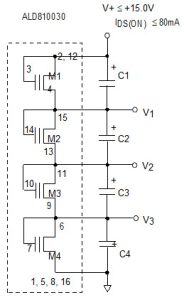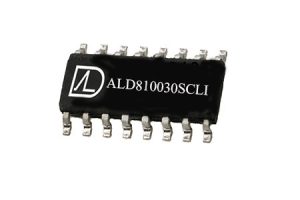
Like other balance ICs in the company’s range, it does not use op-amps and a voltage reference. Instead it has four precision-trimmed mosfets that act as shunt regulators when connected gate-to-drain.
Called ALD810030, its mosfets typically have these V-I characteristics:
- 2.80V 0.01µA
- 2.90V 0.1µA
- 3.00V 1µA
- 3.10V 1µA
- 3.24V 100µA
- 3.34V 300µA
- 3.52V 1mA
“The mosfets can balance two to four supercaps with very small voltage differences, and dissipate no power beyond the leakage current differences,” according to the company. They “offer a simple and effective method to balance and regulate supercapacitors”.

Voltage difference between the four mosfets is typically 5mV (20mV max) – there is a caveat here: this is quoted between mosfets 1 and 2, or 3 and 4, but not between 1 and 3 or 2 and 4.
Operation is over -40 to +85°C, and temperature coefficient is -2.2mV/°C at 1μA. There is also a 0°C to +70°C version – delete the last I from the part number.
Abs maxs are 15V and 80mA. Packaging is 16pin SOIC.
Looking at the characteristics, this IC only suits trickle charged supercaps. The company sees applications in actuators, telematics, solar panels, emergency lighting, security equipment, barcode scanners, metering boxes and battery back-up.
ALD810030SCLI is available from Digi-Key or Mouser.
Supercap maker Wurth has a thorough application note comparing different super-cap balancing techniques including Advanced Linear Devices’ mosfets.
—
